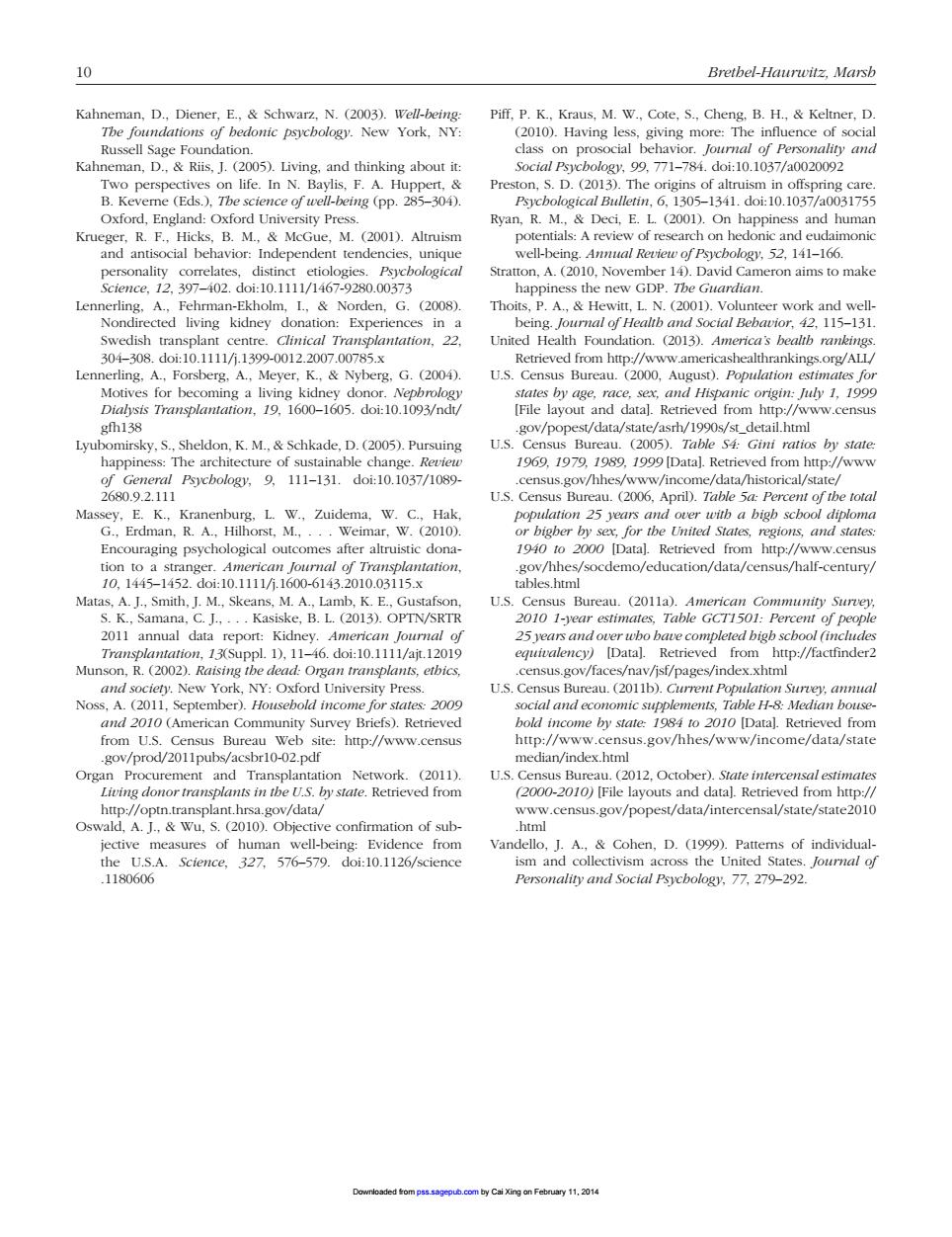正在加载图片...

Bretbel-Haurwitz,Marsb Kahneman,D..Diener,E&Schwarz.N.(2003).Well-being: Piff,P.K..Kraus,M.W..Cote.S.,Cheng.B.H.,Keltner.D. onic psycbology.New York,NY Kahneman,D.&.(005).Living,and thinking about it: Oxford.England:Oxford University Pres Ryan,R.M..Deci,E.L (2001 .On happiness and humar 5211-16 Fehrman-Ekholm Norden.G.(2008). Thos.P.A.Hew work and well Nondirected living Experiences in a 04308.d0t01A1309.001220070075X tation,22. lennerling.A.Forsberg.A..Meyer.K&Nyberg.G.(00) U.S.Census Bureau (0.August).Population estimates fo Dialysis.1600-1605.doi:101093/nd M..Schkade.D.(2005 Psycbology.9.111-131.doi:10.1037/1089 。 Kranenburg.L W.,Zuidema,W.C.. Hak and over witb a bigh scbool diplome eim and state tion to a s ican fou Tr ovhey/socdemoedaioVatay/enslshaiceauny (2011a. mana.C.I. 2010 1-year estimates. Munson,R(02).Raising tbe dea ensus.gov/faces/nav/jsf/pages/index.xhtml U.S.Ce and 2010 (An ne by state. tion Network optn.tra splant.hrsa.gov/data/ gov/popest/data/intercensal/state/ Oswald,A..&Wu,S.(2010).Objective confirmation of sub the U.S.A.Sclence.32.576-579.doi:10.1126/scicnce .1180606 Personality and Social Psycbology.77.279-29210 Brethel-Haurwitz, Marsh Kahneman, D., Diener, E., & Schwarz, N. (2003). Well-being: The foundations of hedonic psychology. New York, NY: Russell Sage Foundation. Kahneman, D., & Riis, J. (2005). Living, and thinking about it: Two perspectives on life. In N. Baylis, F. A. Huppert, & B. Keverne (Eds.), The science of well-being (pp. 285–304). Oxford, England: Oxford University Press. Krueger, R. F., Hicks, B. M., & McGue, M. (2001). Altruism and antisocial behavior: Independent tendencies, unique personality correlates, distinct etiologies. Psychological Science, 12, 397–402. doi:10.1111/1467-9280.00373 Lennerling, A., Fehrman-Ekholm, I., & Norden, G. (2008). Nondirected living kidney donation: Experiences in a Swedish transplant centre. Clinical Transplantation, 22, 304–308. doi:10.1111/j.1399-0012.2007.00785.x Lennerling, A., Forsberg, A., Meyer, K., & Nyberg, G. (2004). Motives for becoming a living kidney donor. Nephrology Dialysis Transplantation, 19, 1600–1605. doi:10.1093/ndt/ gfh138 Lyubomirsky, S., Sheldon, K. M., & Schkade, D. (2005). Pursuing happiness: The architecture of sustainable change. Review of General Psychology, 9, 111–131. doi:10.1037/1089- 2680.9.2.111 Massey, E. K., Kranenburg, L. W., Zuidema, W. C., Hak, G., Erdman, R. A., Hilhorst, M., . . . Weimar, W. (2010). Encouraging psychological outcomes after altruistic donation to a stranger. American Journal of Transplantation, 10, 1445–1452. doi:10.1111/j.1600-6143.2010.03115.x Matas, A. J., Smith, J. M., Skeans, M. A., Lamb, K. E., Gustafson, S. K., Samana, C. J., . . . Kasiske, B. L. (2013). OPTN/SRTR 2011 annual data report: Kidney. American Journal of Transplantation, 13(Suppl. 1), 11–46. doi:10.1111/ajt.12019 Munson, R. (2002). Raising the dead: Organ transplants, ethics, and society. New York, NY: Oxford University Press. Noss, A. (2011, September). Household income for states: 2009 and 2010 (American Community Survey Briefs). Retrieved from U.S. Census Bureau Web site: http://www.census .gov/prod/2011pubs/acsbr10-02.pdf Organ Procurement and Transplantation Network. (2011). Living donor transplants in the U.S. by state. Retrieved from http://optn.transplant.hrsa.gov/data/ Oswald, A. J., & Wu, S. (2010). Objective confirmation of subjective measures of human well-being: Evidence from the U.S.A. Science, 327, 576–579. doi:10.1126/science .1180606 Piff, P. K., Kraus, M. W., Cote, S., Cheng, B. H., & Keltner, D. (2010). Having less, giving more: The influence of social class on prosocial behavior. Journal of Personality and Social Psychology, 99, 771–784. doi:10.1037/a0020092 Preston, S. D. (2013). The origins of altruism in offspring care. Psychological Bulletin, 6, 1305–1341. doi:10.1037/a0031755 Ryan, R. M., & Deci, E. L. (2001). On happiness and human potentials: A review of research on hedonic and eudaimonic well-being. Annual Review of Psychology, 52, 141–166. Stratton, A. (2010, November 14). David Cameron aims to make happiness the new GDP. The Guardian. Thoits, P. A., & Hewitt, L. N. (2001). Volunteer work and wellbeing. Journal of Health and Social Behavior, 42, 115–131. United Health Foundation. (2013). America’s health rankings. Retrieved from http://www.americashealthrankings.org/ALL/ U.S. Census Bureau. (2000, August). Population estimates for states by age, race, sex, and Hispanic origin: July 1, 1999 [File layout and data]. Retrieved from http://www.census .gov/popest/data/state/asrh/1990s/st_detail.html U.S. Census Bureau. (2005). Table S4: Gini ratios by state: 1969, 1979, 1989, 1999 [Data]. Retrieved from http://www .census.gov/hhes/www/income/data/historical/state/ U.S. Census Bureau. (2006, April). Table 5a: Percent of the total population 25 years and over with a high school diploma or higher by sex, for the United States, regions, and states: 1940 to 2000 [Data]. Retrieved from http://www.census .gov/hhes/socdemo/education/data/census/half-century/ tables.html U.S. Census Bureau. (2011a). American Community Survey, 2010 1-year estimates, Table GCT1501: Percent of people 25 years and over who have completed high school (includes equivalency) [Data]. Retrieved from http://factfinder2 .census.gov/faces/nav/jsf/pages/index.xhtml U.S. Census Bureau. (2011b). Current Population Survey, annual social and economic supplements, Table H-8: Median household income by state: 1984 to 2010 [Data]. Retrieved from http://www.census.gov/hhes/www/income/data/state median/index.html U.S. Census Bureau. (2012, October). State intercensal estimates (2000-2010) [File layouts and data]. Retrieved from http:// www.census.gov/popest/data/intercensal/state/state2010 .html Vandello, J. A., & Cohen, D. (1999). Patterns of individualism and collectivism across the United States. Journal of Personality and Social Psychology, 77, 279–292. Downloaded from pss.sagepub.com by Cai Xing on February 11, 2014